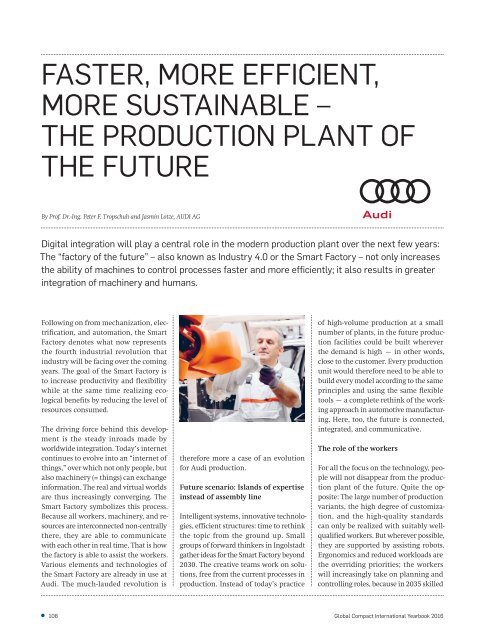Global Compact International Yearbook 2016
The Sustainable Development Goals are an ambitious agenda with 17 topics addressing the global challenges of our time. A key topic is innovation: Business must fit into planetary boundaries. This probably will not work with traditional business models. That is why we need new, fresh ideas. We need change, even when it happens in a rough, disruptive way. And the earlier the better. This is why the upcoming edition of the Global Compact International Yearbook, published in September 2016, has chosen sustainable innovation as the key topic. Also includes exclusive interviews with Angelina Jolie, Robert Redford and Sigourney Weaver. The Global Compact International Yearbook is with more than 500,000 readers one of the worlds leading CSR publications. Münster/New York 2016: 164 pages, paperback Publishing houses: macondo publishing/UN Publications Subscription (via UN Publications only): 30.00 USD (regular) 15.00 USD (reduced) ISBN13: 978-3-946284-01-7 / ISSN-Print: 2365-3396 / ISSN-Internet: 2365-340x
The Sustainable Development Goals are an ambitious agenda with 17 topics addressing the global challenges of our time. A key topic is innovation: Business must fit into planetary boundaries. This probably will not work with traditional business models. That is why we need new, fresh ideas. We need change, even when it happens in a rough, disruptive way. And the earlier the better. This is why the upcoming edition of the Global Compact International Yearbook, published in September 2016, has chosen sustainable innovation as the key topic.
Also includes exclusive interviews with Angelina Jolie, Robert Redford and Sigourney Weaver.
The Global Compact International Yearbook is with more than 500,000 readers one of the worlds leading CSR publications.
Münster/New York 2016: 164 pages, paperback
Publishing houses: macondo publishing/UN Publications
Subscription (via UN Publications only): 30.00 USD (regular) 15.00 USD (reduced)
ISBN13: 978-3-946284-01-7 / ISSN-Print: 2365-3396 / ISSN-Internet: 2365-340x
You also want an ePaper? Increase the reach of your titles
YUMPU automatically turns print PDFs into web optimized ePapers that Google loves.
Faster, More Efficient,<br />
More Sustainable –<br />
The Production Plant of<br />
the Future<br />
By Prof. Dr.-Ing. Peter F. Tropschuh and Jasmin Lotze, Audi AG<br />
Digital integration will play a central role in the modern production plant over the next few years:<br />
The “factory of the future” – also known as Industry 4.0 or the Smart Factory – not only increases<br />
the ability of machines to control processes faster and more efficiently; it also results in greater<br />
integration of machinery and humans.<br />
Following on from mechanization, electrification,<br />
and automation, the Smart<br />
Factory denotes what now represents<br />
the fourth industrial revolution that<br />
industry will be facing over the coming<br />
years. The goal of the Smart Factory is<br />
to increase productivity and flexibility<br />
while at the same time realizing ecological<br />
benefits by reducing the level of<br />
resources consumed.<br />
The driving force behind this development<br />
is the steady inroads made by<br />
worldwide integration. Today’s internet<br />
continues to evolve into an “internet of<br />
things,” over which not only people, but<br />
also machinery (= things) can exchange<br />
information. The real and virtual worlds<br />
are thus increasingly converging. The<br />
Smart Factory symbolizes this process.<br />
Because all workers, machinery, and resources<br />
are interconnected non-centrally<br />
there, they are able to communicate<br />
with each other in real time. That is how<br />
the factory is able to assist the workers.<br />
Various elements and technologies of<br />
the Smart Factory are already in use at<br />
Audi. The much-lauded revolution is<br />
therefore more a case of an evolution<br />
for Audi production.<br />
Future scenario: Islands of expertise<br />
instead of assembly line<br />
Intelligent systems, innovative technologies,<br />
efficient structures: time to rethink<br />
the topic from the ground up. Small<br />
groups of forward thinkers in Ingolstadt<br />
gather ideas for the Smart Factory beyond<br />
2030. The creative teams work on solutions,<br />
free from the current processes in<br />
production. Instead of today’s practice<br />
of high-volume production at a small<br />
number of plants, in the future production<br />
facilities could be built wherever<br />
the demand is high – in other words,<br />
close to the customer. Every production<br />
unit would therefore need to be able to<br />
build every model according to the same<br />
principles and using the same flexible<br />
tools – a complete rethink of the working<br />
approach in automotive manufacturing.<br />
Here, too, the future is connected,<br />
integrated, and communicative.<br />
The role of the workers<br />
For all the focus on the technology, people<br />
will not disappear from the production<br />
plant of the future. Quite the opposite:<br />
The large number of production<br />
variants, the high degree of customization,<br />
and the high-quality standards<br />
can only be realized with suitably wellqualified<br />
workers. But wherever possible,<br />
they are supported by assisting robots.<br />
Ergonomics and reduced workloads are<br />
the overriding priorities; the workers<br />
will increasingly take on planning and<br />
controlling roles, because in 2035 skilled<br />
108<br />
<strong>Global</strong> <strong>Compact</strong> <strong>International</strong> <strong>Yearbook</strong> <strong>2016</strong>

















